Vibrating element (VBE) type gas measurement devices measure refinery reformer stream compositions, power generator hydrogen purity, centripetal compressor gas inputs, process heater fuel gas quality, and others in multiple process control environments.
 Vibrating element gas measurement technology is a viable alternative to traditional gas measurement methods and a versatile tool for process control. Gas properties analysis is required for many manufacturing processes. Refineries, chemical plants, power plants, pulp and paper mills, and other industries use gas chromatography (GC), infrared (IR), flame ionization detectors (FID), thermal conductivity detectors (TCD). and other technologies to determine process gas properties or gas stream composition.
Vibrating element gas measurement technology is a viable alternative to traditional gas measurement methods and a versatile tool for process control. Gas properties analysis is required for many manufacturing processes. Refineries, chemical plants, power plants, pulp and paper mills, and other industries use gas chromatography (GC), infrared (IR), flame ionization detectors (FID), thermal conductivity detectors (TCD). and other technologies to determine process gas properties or gas stream composition.
The vibrating element type gas measurement method is a reasonably matured technology. Only recently, however, has it been used for process control Trade magazines such as Mechanical Engineering and Control and Power have documented the effectiveness of using vibrating element type devices to measure gas properties in a variety of process control environments. Customers using vibrating element technology report better performance, lower maintenance, and more efficient process control.
The devices work on the general principle that the resonant frequency of a thin wall cylinder will change as the density of the surrounding gas varies. Also known as the tuning fork method, it is best exemplified in the reaction of the human voice to helium gas. Once inhaled, a person’s voice pitch increases dramatically because helium gas has less density than air. The vocal cords vibrate faster, causing a higher pitch sound.
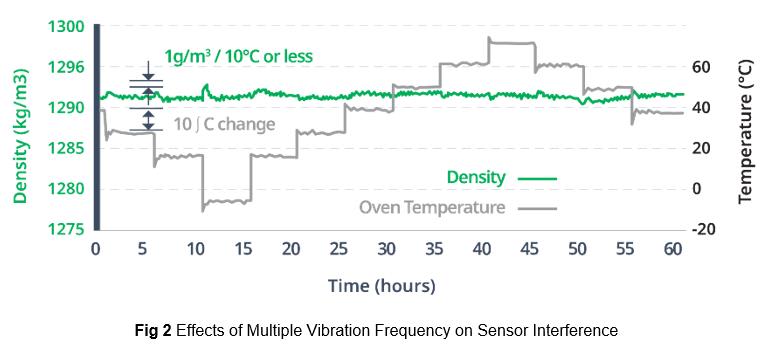 For vibrating element devices, the cylinder vibration frequency measurement indicates the surrounding gas’s density. A lighter gas allows the cylinder to vibrate faster. Piezoelectric elements make the density measurement. One element vibrates the cylinder at two independent frequencies, another measures the resultant vibration frequencies. Gas density is determined from the two frequencies’ ratio. It is important to measure two independent frequencies to maintain accuracy and stability during ambient and gas process temperature changes (Fig 2). The frequency ratio is virtually independent of Young’s Modulus and temperature effects on the cylinder material. It is also responsible for the device’s resistance to dust, oil, or water accumulation on the vibration cylinder (Fig 2)4.
For vibrating element devices, the cylinder vibration frequency measurement indicates the surrounding gas’s density. A lighter gas allows the cylinder to vibrate faster. Piezoelectric elements make the density measurement. One element vibrates the cylinder at two independent frequencies, another measures the resultant vibration frequencies. Gas density is determined from the two frequencies’ ratio. It is important to measure two independent frequencies to maintain accuracy and stability during ambient and gas process temperature changes (Fig 2). The frequency ratio is virtually independent of Young’s Modulus and temperature effects on the cylinder material. It is also responsible for the device’s resistance to dust, oil, or water accumulation on the vibration cylinder (Fig 2)4.
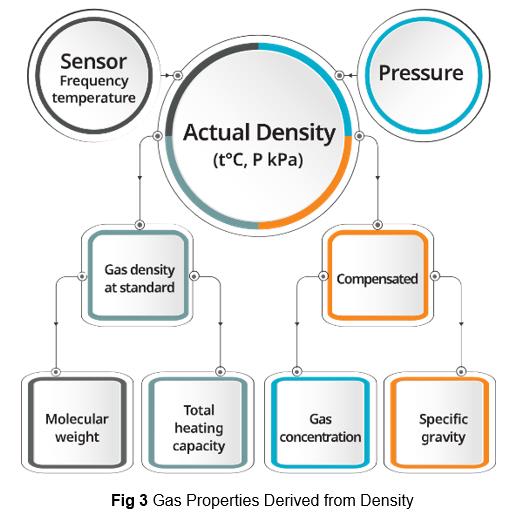 Most available devices can output gas density or caloric value. Some can simultaneously output or display multiple parameters including combinations of (Fig 3):
Most available devices can output gas density or caloric value. Some can simultaneously output or display multiple parameters including combinations of (Fig 3):
- Specific gravity
- Density caloric value,
- Molecular weight
- Percent gas concentration
This improved output set increases the device’s versatility, making it effective for multiple applications. In particular, the percent gas concentration function is useful for measurements traditionally taken with thermal conductivity devices.
With products covering a variety of price and performance ranges, there are many thermal conductivity device suppliers. Their devices use the thermal conductivity of the process gas stream to cool one side of a Wheatstone Bridge. The bridge circuit produces similar output voltage as the thermal conductivity of the gas changes.
Generally, thermal conductivity devices require an isothermal environment and stable gas flow rates; many require a constant stream of reference gas. Thermal conductivity devices can be used to measure gas percent concentration, gas density, and specific gravity. Some thermal conductivity devices can achieve parts per billion (PPB) level gas component resolution and 0.1% reading accuracy.
Vibrating element technology is notably suited for field measurement conditions. In contrast to many thermal conductivity devices, it does not require reference gas, an isothermal environment, warm up, or temperature stabilization time. There is a linear relationship between gas density and the cylinder vibration frequency so calibrations use two off-the-shelf gases. The gas concentration measurement using vibrating element devices, like thermal conductivity, are relegated to binary or pseudo-binary gas streams. The measurement is not species specific for a particular gas in a mixture. The device correlates changes in gas density to changes in gas composition. Measurements for specific gravity or molecular weight are taken directly.
Refineries and chemical plants have a variety of applications for vibrating element technology (Fig.4). Hydrogen (H2) is a critical element to many of the refinery processes. Hydrogenation, Catalytic reforming, Hydrocracking, and Hydrotreating are examples where the process yield is dependent on the partial pressure of hydrogen gas (Fig.5). If the purity of the surrounding hydrogen is insufficient, the process efficiency can be compromised and the active catalysts damaged. Thus, knowing the process hydrogen concentration is critical to process performance 2 3.
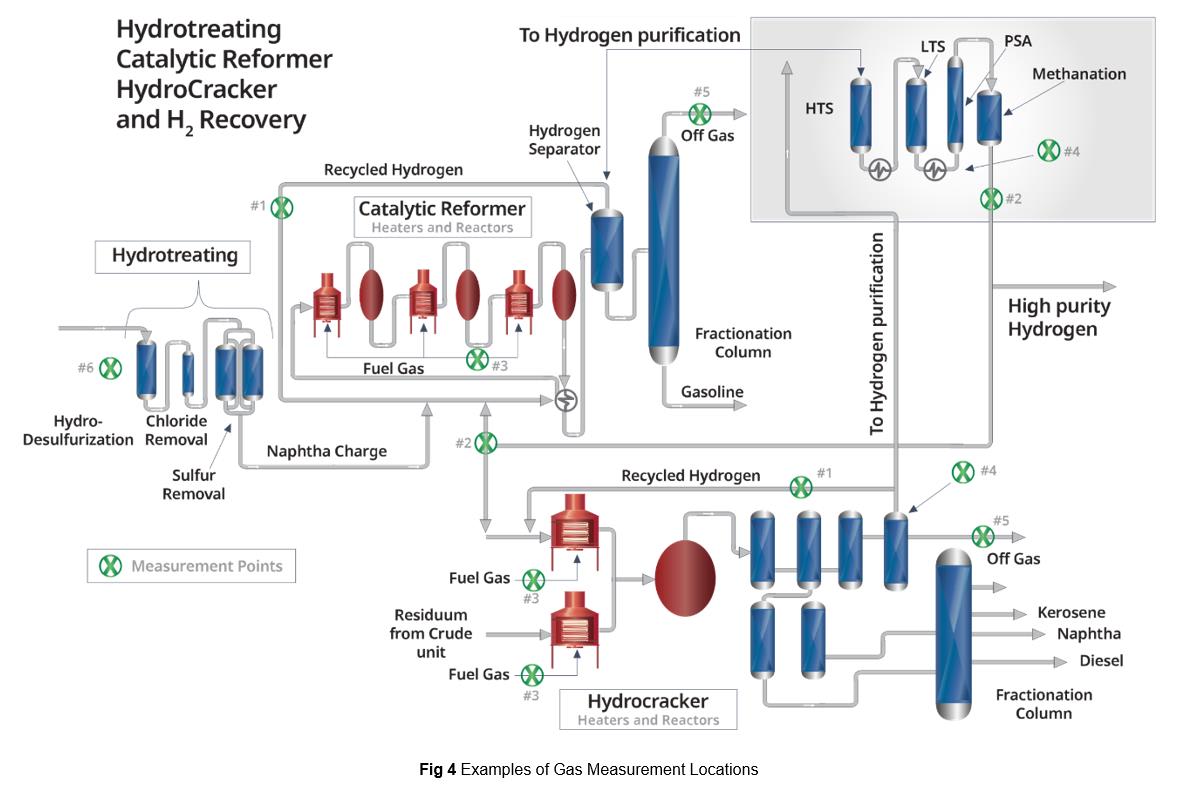
A process engineer for ConocoPhillips, Wood River refinery (IL), explains that hydrogen purity is key in preventing catalyst activity loss on a naphtha reformer six. Typically, a catalytic reformer exit stream composition has 75-80% H2. The remaining background gas is a mixture of Carbon Dioxide (CO2) and various hydrocarbons. Pure hydrogen gas is mixed with the exit stream to maintain a minimum hydrogen purity level of the exit gas which is returned to the reformer or used as a feed gas to other refinery processes such as a hydrocracking and hydro treating. The hydrogen gas concentration on Wood River’s naphtha reformers is determined from a specific gravity measurement of the hydrogen vent stream from the product separator. The gas specific gravity value is correlated to hydrogen purity and used to control the mixing of exit stream gas with pure hydrogen.
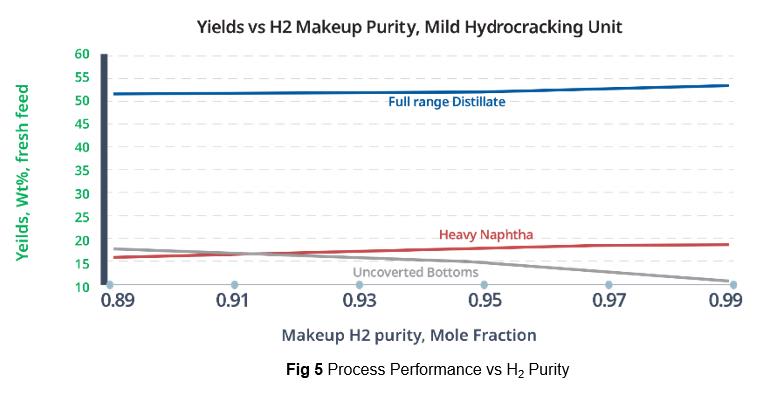 When a thermal conductivity device is used for the reformer hydrogen measurement application, it is generally assumed that the background gas is homogeneous CO2 for the purpose of simple, predictable linearization. The assumption can result in errors as the actual background gas thermal conductivity differs from the assumed value. Some thermal conductivity manufacturers correct for the variety of the background gas by using complex, custom calibration gases. One manufacturer suggests using a seven component calibration gas to compensate for the problem of background gas variation.
When a thermal conductivity device is used for the reformer hydrogen measurement application, it is generally assumed that the background gas is homogeneous CO2 for the purpose of simple, predictable linearization. The assumption can result in errors as the actual background gas thermal conductivity differs from the assumed value. Some thermal conductivity manufacturers correct for the variety of the background gas by using complex, custom calibration gases. One manufacturer suggests using a seven component calibration gas to compensate for the problem of background gas variation.
In many cases, vibrating element technology is preferred over thermal conductivity for this measurement because of its field adaptability and its ability to compensate for the specific composition of the process background gas. Some vibrating element devices allow the user to program the mean density of the background gas into the gas percent calculation.
There is heightened emphasis on the value of hydrogen and errors in the gas measurement caused by background gas assumptions can be costly.
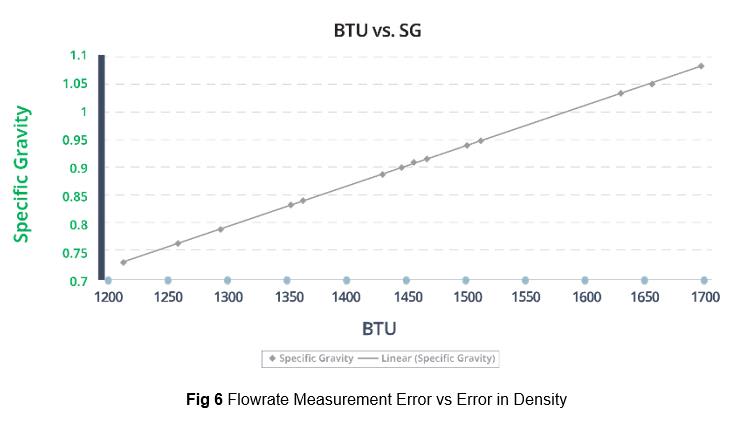 Wood River Refinery also uses vibrating element devices to correct orifice type flowmeters for changes in fuel gas specific gravity. The correction is important for flow meter accuracy when process changes result in varying fuel gas composition. The refinery uses Foxboro type flowmeters to control fuel mixtures to the plant process heaters. The fuel gas is a composite of refinery tail gas and natural gas (NG). Errors in the flowrate measurements can affect the process heater combustion process; increasing emissions, fuel usage, and operational costs (Fig 6). The plants general summary of the two VBE devices installed three years ago is: “The vibrating element devices work well; better than the previous product. The specific gravity output is a good backup measurement to the plant’s gas chromatograph (GC) BTU measurement”, the quote is referring to the relationship between specific gravity and fuel BTU value (Fig 7). The VBE devices are faster and more reliable than the GC but not as accurate. A GC has a higher accuracy and can speciate a process stream, but at nearly four times the cost of a VBE device 5.
Wood River Refinery also uses vibrating element devices to correct orifice type flowmeters for changes in fuel gas specific gravity. The correction is important for flow meter accuracy when process changes result in varying fuel gas composition. The refinery uses Foxboro type flowmeters to control fuel mixtures to the plant process heaters. The fuel gas is a composite of refinery tail gas and natural gas (NG). Errors in the flowrate measurements can affect the process heater combustion process; increasing emissions, fuel usage, and operational costs (Fig 6). The plants general summary of the two VBE devices installed three years ago is: “The vibrating element devices work well; better than the previous product. The specific gravity output is a good backup measurement to the plant’s gas chromatograph (GC) BTU measurement”, the quote is referring to the relationship between specific gravity and fuel BTU value (Fig 7). The VBE devices are faster and more reliable than the GC but not as accurate. A GC has a higher accuracy and can speciate a process stream, but at nearly four times the cost of a VBE device 5.
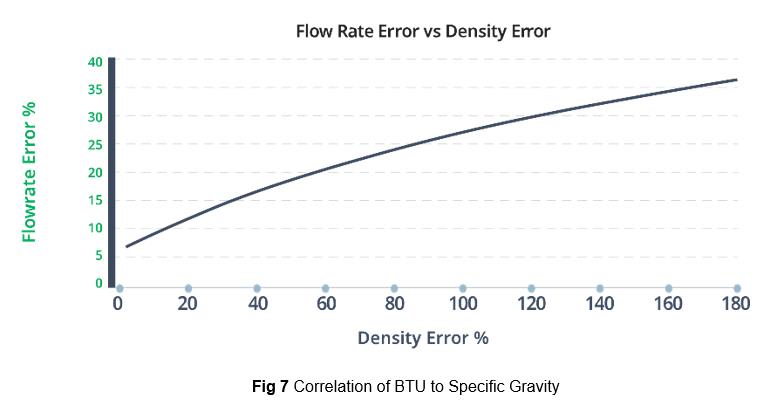 Wood River replaced mechanical gravitometers, citing expensive, extremely complex, 1970’s technology, and weekly calibration checks as reasons for evolving to VBE devices.
Wood River replaced mechanical gravitometers, citing expensive, extremely complex, 1970’s technology, and weekly calibration checks as reasons for evolving to VBE devices.
The BP, Texas City refinery (TX) uses vibrating element measurement devices in a similar fuel gas application. The new product replaced mechanical gravitometers, which use purely mechanical means to make the specific gravity measurement. “The old instrument was a nightmare to maintain. It had too many veins, the belts frequently broke, and the accuracy was uncertain. The VBEs are believable, and have temperature and pressure compensation”, says a Texas City, Analyzer Supervisor 7.
Gas compressor surge control is another refinery area where VBE devices are utilized. VBE technology excels in this application because of its resistance to fluid contamination and its fast response time. Thermal conductivity devices advertise 5-40 seconds (T90) response times. VBE devices measure 90% of full scale (T90) in less than five seconds (T90<5s). This is an important distinction when monitoring for sudden process upsets.
A VBE device measures the gas specific gravity (SG) at the inlet to centripetal type gas compressors in many cases. The SG value is used in the compressor control scheme to prevent “free spinning” the compressor when the process gas mixture lightens due to a surge of light hydrocarbons. Two vibrating element devices at Texas City are installed on compressors used in the Coking process. Two VBE devices at Wood River are used on compressors sending recycled hydrogen back to a hydrocracker from a steam methane reformer 5 7.
Both plants agree that the product installations were relatively trouble free and utilized the existing piping and sample systems. It was also agreed that the installation of vibrating element products reduce maintenance times and improves the accuracy of the measurements, saving money and justifying outdated technology replacement.
Power generation industries have also reported tremendous success using vibrating element devices on hydrogen cooled generators (Fig. 8). Large power generators use pure hydrogen to cool and insulate power generator electrical windings. Inexpensive and readily available, hydrogen is the choice insulator because its low density and high thermal conductivity provide the best environment for generator operation.
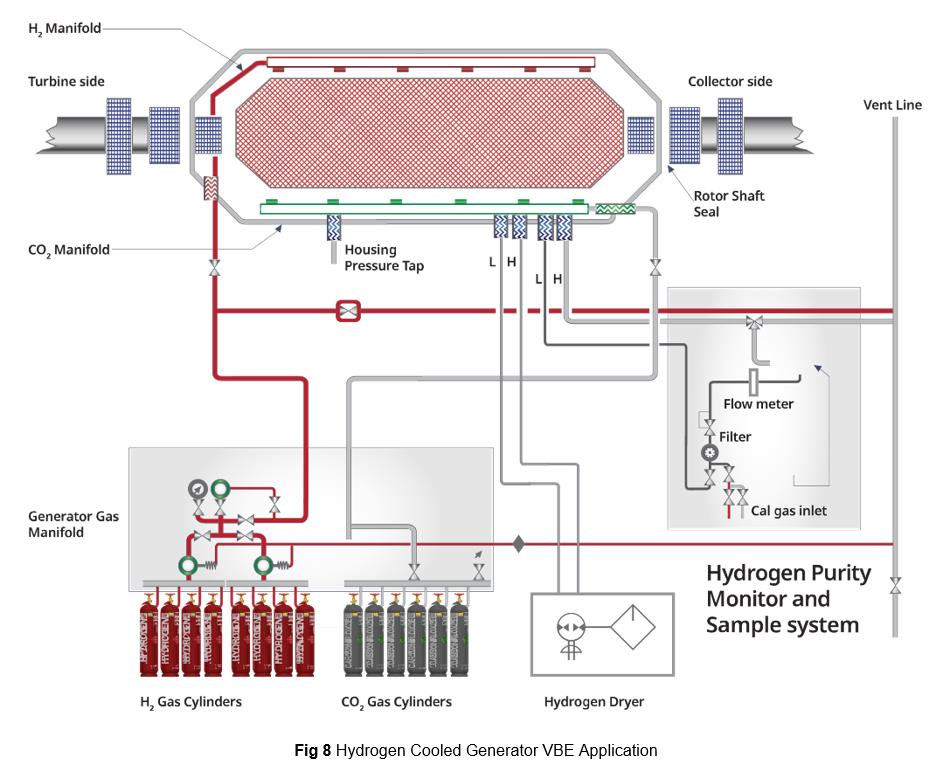
Contaminated H2 reduces the generator efficiency. The drag on rotating parts increases and the ability to carry heat from the windings decreases as the hydrogen becomes contaminated. Air is the most common contaminant, originating from leaking rotor shaft seals. A 2% change in hydrogen purity can cost thousands of dollars per day in generator operating expenses.
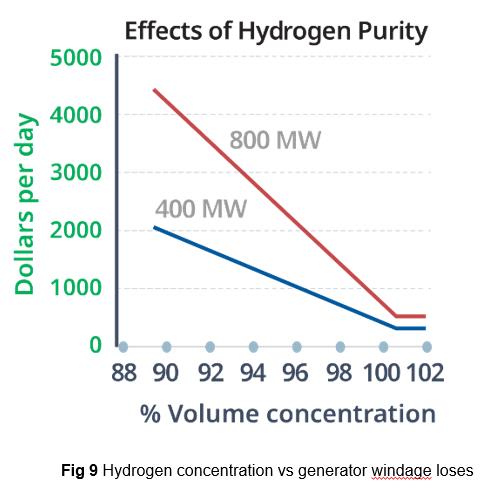 Historically, generator hydrogen purity was measured with thermal conductivity or mechanical fan differential devices. Three years ago, Southern Company’s, Georgia Power Plant Yates (GA) switched from thermal conductivity analyzers to vibrating element type hydrogen measurement. Plant users cite many reasons for the plant wide conversion of seven GE generators totaling near 1300MW. According to the operators, “the thermal conductivity analyzer’s accuracy was suspect and generally unreliable.” They had difficulty calibrating the thermal conductivity instrument, and as a result, could not trust the measurement. “Verifying the accuracy of the old unit was difficult because we could not get support from the vendor. High quality service is the bottom line.”
Historically, generator hydrogen purity was measured with thermal conductivity or mechanical fan differential devices. Three years ago, Southern Company’s, Georgia Power Plant Yates (GA) switched from thermal conductivity analyzers to vibrating element type hydrogen measurement. Plant users cite many reasons for the plant wide conversion of seven GE generators totaling near 1300MW. According to the operators, “the thermal conductivity analyzer’s accuracy was suspect and generally unreliable.” They had difficulty calibrating the thermal conductivity instrument, and as a result, could not trust the measurement. “Verifying the accuracy of the old unit was difficult because we could not get support from the vendor. High quality service is the bottom line.”
The Yates plant operators appreciated the simple replacement of their old thermal conductivity systems, especially the new speed of calibration. “It takes me longer to walk down to the analyzer than it does to calibrate it,” says a Yates technician.
TVA, Kingston fossil plant (TN) decided to upgrade their hydrogen gas purity measurement, replacing nine thermal conductivity analyzers with vibrating element devices. The analyzers are used to measure hydrogen gas purity on five GE 200 MW and four Westinghouse 150MW generators. Kingston’s management team evaluated recommendations and due to the thermal conductivity analyzers’ excessive maintenance, support issues, and manpower expenditure, chose to replace the existing hydrogen purity meters.
TVA reports that the vibrating element product improves repeatability and lacks measurement drift. The thermal conductivity systems were experiencing drift on the order of 1% hydrogen between calibration intervals. They required biweekly calibrations to stay within the generator operational tolerances for gas purity. The calibration of the thermal conductivity system required a minimum of eight man-hours. The new products require less than three hours to calibrate all nine. The VBEs have been installed for a year and the Kingston Plant has been conducting drift and calibration checks on the old preventative maintenance schedule. The schedule has been modified based on the lack of measurement drift eight.
Conclusion
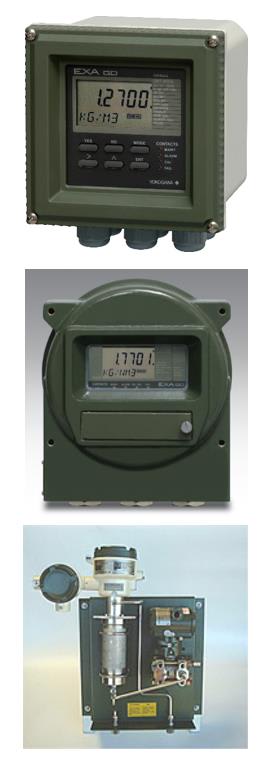 There are instances where traditional gas measurement cannot be replaced. The measurement may require it to be species specific, have better resolution, or another unsurpassed performance characteristic. But, in many instances of gas properties measurement for density, specific gravity or gas percent concentration, the vibrating element technology is a viable, proven, and cost competitive alternative.
There are instances where traditional gas measurement cannot be replaced. The measurement may require it to be species specific, have better resolution, or another unsurpassed performance characteristic. But, in many instances of gas properties measurement for density, specific gravity or gas percent concentration, the vibrating element technology is a viable, proven, and cost competitive alternative.
Key Benefits
The GD402 is a gas density analyzer with a rugged microprocessor-based converter designed in two versions to meet both general area and explosion-proof application requirements. In addition to the display of several key data items, the converter also provides the choice of three different means for calibration: automatic, semi-automatic, and one-touch manual operation.
Features of the GD402 include:
- Proven design
- Many detector features
- Simple interface
- Low installation cost
The GD40 is a gas density detector designed for intrinsically safe and flameproof, explosion protected applications. It is virtually maintenance free for all accepted applications.
Features of the GD40 include:
- Low installation cost
- Virtually maintenance free
- Not affected by dust or oil mist
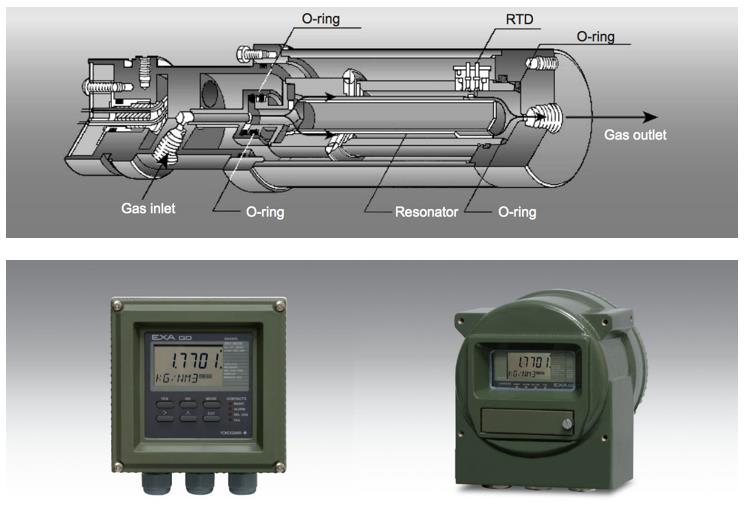
References
- Emerson Analytical, 2004 “Process Gas Monitoring in Petroleum Refineries”
- Paul R. Robinson, “ Catalyst Life Management with Predictive Deactivation Model”
- Nick Hallale and Ian Moore, “Hydrogen: Liability or Asset?” CEP magazine Sept 2002
- Suzuki Jun-ichi,, “GD series Vibratory Gas density Meters” Yokogawa document 1997
- Dave Crocket, technical analyzer specialist Analyzer, ConocoPhillips, Wood River refinery (IL) “interview on vibrating element performance”, 2003
- Paul Pizzini, process engineer, ConocoPhillips, Wood River refinery (IL) “interview on vibrating element performance”, 2003
- Neil McDuffie, analyzer supervisor, BP, Texas City refinery (TX), “interview on vibrating element performance”, 2003
- Craig Self, Senior Instrument Mechanical Foreman ,TVA, Kingston fossil plant (Tn), “interview on vibrating element performance”, 2002
- Vibrating Element Technology: Measurement of Gas Density, Specific Gravity and Hydrogen Purity Webinar
Industries
-
Chemical
Chemical plants rely on continuous and batch production processes, each posing different requirements for a control system. A continuous process calls for a robust and stable control system that will not fail and cause the shutdown of a production line, whereas the emphasis with a batch process is on having a control system that allows great flexibility in making adjustments to formulas, procedures, and the like. Both kinds of systems need to be managed in available quality history of product, and to be able to execute non-routine operations. With its extensive product portfolio, experienced systems engineers, and global sales and service network, Yokogawa has a solution for every plant process.
-
Oil & Gas
Yokogawa has a wealth of experience in every part of the oil and gas business, from offshore and onshore facilities to pipelines, terminals, and deepwater operations. We provide solutions that enhance safety, ensure accurate and reliable operation, and increase plant efficiency.
-
Power
In the mid 1970s, Yokogawa entered the power business with the release of the EBS Electric Control System. Since then, Yokogawa has steadfastly continued with the development of our technologies and capabilities for providing the best services and solutions to our customers worldwide.
Yokogawa has operated the global power solutions network to play a more active role in the dynamic global power market. This has allowed closer teamwork within Yokogawa, bringing together our global resources and industry know-how. Yokogawa's power industry experts work together to bring each customer the solution that best suits their sophisticated requirements.
-
Pulp & Paper
The paper and pulp industry is highly competitive and must meet ever-changing market needs. Yokogawa helps realize energy-efficient plants which are globally sustainable.
-
Refining
In the ever-changing marketplace, refineries are seen not only as crude processing units but also as profit centers. At the same time, there is a keen awareness of the need for safety at such facilities. A total production solution that encompasses planning, scheduling, management, and control is required to achieve long-term goals for profitability, efficiency, and environmental protection. With years of expertise in the automation field, Yokogawa can bring you affordable total solutions for improved operability and a cleaner world.
Related Products & Solutions
-
GD402/GD40 Gas Density Analyzer
The GD402 gas density analyzer and GD40 gas density detector provide continuous measurement of gas density as well as other valuable parameters, including specific gravity and percent concentration.
-
Gas Analyzers
Enhance efficiency, safety, throughput, and product quality with real-time gas analysis.
-
Gas Density/Hydrogen Purity Analyzer
- Gas density analyzers/hydrogen gas analyzer
- Continuous measurement of gas density
- Other valuable parameters, including specific gravity, density of hydrogen gas, and percent concentration
Have Questions?
Contact a Yokogawa Expert to learn how we can help you solve your challenges.